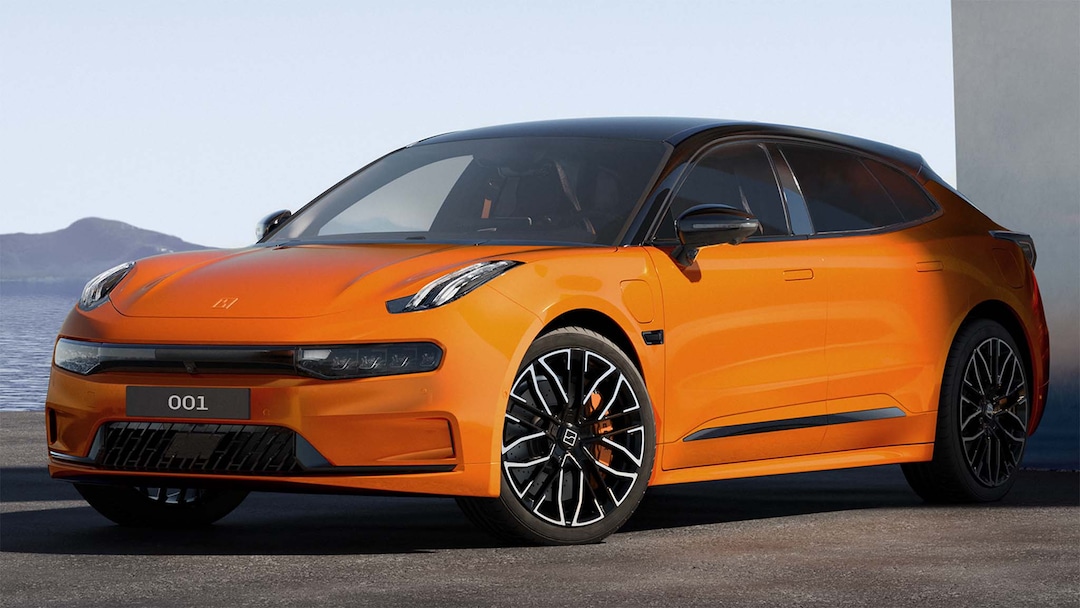Zeekr 001 EV Sedan
The Zeekr 001 is an all-electric compact shooting brake sedan design based on the Geely group’s SAE platform. The top-line all-wheel-drive model we drove churns out 536 horsepower and 516 lb-ft of torque from two e-motors, one driving each axle, offering a claimed range of more than 430 miles. A rear-wheel-drive, single-motor model good for 268 hp is also available, and a limited high-performance 140-kWh version of the Zeekr 001 also sold this year claiming 1,248 hp and 640 miles of range.
If the 001 design seems familiar, it’s because it started life as a Lynk&Co concept car for a ride-sharing sales model that was then extrapolated into the Zeekr brand for commercial sales of individual cars in 2021. Under the skin, the 001 also has a lot in common with the upcoming U.S.-market Polestar 4 compact sedan, so we might be able to expect a similar 86- to 100-kWh battery back range, between 250 and 600 hp, and rear- and all-wheel-drive arrangements when the 4 goes on sale here in later 2024.

Zeekr 009 EV Van
The aggressively styled Zeekr 009 is an all-electric six-seat luxury MPV for China based on the same platform as the 001 shooting brake. It gets either a 116-kWh or 140-kWh battery pack good for more than 500 miles of claimed range and up to 536 hp. That’s the same power as the 001 with more weight, but we ended up enjoying the van more than the sedan on our brief track drive.
(Briefly) On Track
Considering Zeekr’s lack of U.S.-market sales ambition, there’s no government safety homologation done on any of its current vehicles, and so we couldn’t drive the 001 or 009 on public roads. However, Zeekr did ship the cars all the way over to Monticello Motor Club in New York for select media to drive on a closed track. Our initial impression is that track driving may not yet be a regular occurrence for casual vehicle owners in China, nor the development teams at Zeekr, considering the vehicle dynamics we experienced.
To Zeekr’s credit, both the 001 and 009 are quick enough in a straight line, but they don’t quite offer that Tesla-level burst of instant torquey acceleration you might expect, as if the traction management system is perhaps overly suspicious of the tires, or the cars are just that heavy; it’s a bit of a dull power curve compared to the whiplash you could expect from an AWD EV, but that could be programmed into the car for a more luxurious and sweeping take-off. You get going quick enough, regardless, and it can find room to accelerate more even at higher speeds.

In the 001, though, the powerband felt all over the place and unpredictable in the curves, and we couldn’t quite ever place where the car was sending us next. The power management between the front and rear motors wasn’t quite cohesive, with some stuttering at the front and understeer and the ever-present hint that the car hadn’t been programmed for a true track drive quite yet. The car liked it when the steering was straight but seemed to interfere or hesitate when power was demanded exiting corners. You don’t need to play interpreter in the comparable Tesla Model 3 because it doesn’t noticeably question itself when you demand it take a corner at speed; the Tesla feels far more seamless in its power delivery. The traction control system was overly aggressive, reflecting a lacking track-dedicated drive mode that removes those sorts of things, so perhaps the 001 deserves another tune and a fairer shakedown again in the future. Perhaps the Polestar 4 will come better prepared.
The 009 van was more impressive on the two track laps we got (which admittedly is not much), with a claimed 0-60-mph acceleration time of 4.5 seconds. A giant luxury MPV managing to hustle its way around a racetrack is an easy trick; even loaded up with four people on a lap, the van managed to move its weight well and didn’t laughably roll out of the corners. It held tight on its wheels, and the tires hardly even squealed, though it lacked the power to truly do any showing off if you wanted to, which could probably be supplied by an upgraded performance 009 variant if Zeekr wanted to really impress in the future. It was luxuriously speedy off the line but far shy of anything properly ludicrous at the track.

Robotaxi With Waymo
Tucked over in the corner of the event at Monticello Motor Club was the so-far-unnamed driverless mobility concept Zeekr has designed in partnership with Waymo as a future ride-hailing service vehicle. It features split-opening sliding doors on both sides and is built upon the same all-electric SAE architecture as the Zeekr 001 and 009. Representatives told us it can still be fitted with traditional vehicle driver controls, or without, pending future legislation in different markets. There’s no specific launch date for this one, but it would theoretically eventually supplement and replace Waymo’s current Jaguar I-Pace electric SUVs (and a hodgepodge of other models) in the fleet, and it’s the only Zeekr so far that could actually end up on U.S. streets in the next decade.

Coming to America?
There are no confirmed ambitions for a U.S.-market launch of Zeekr’s own cars, at least not in the foreseeable future. Geely is still heavily invested in launching all-electric Volvo and Polestar models, which it can also manufacture locally at its South Carolina facility. Many of Zeekr’s vehicles share enough components with Geely’s other brands going on sale soon in the U.S.; given the uninspired on-track performance we experienced, which is fair for a luxury-oriented city car, we aren’t missing out on much more than Zeekr’s unique design approach so far considering we now have Polestar and Volvo at home.




